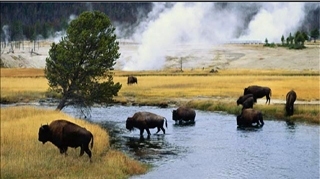Streetcars
Introduction
We mourned the passing of Judge Wolf within this past
month. He was very interested in the history of Kearney. Somehow
over the years he had acquired a piece of Kearney's streetcar rail.
During our Q125
Celebration Judge Wolf made some souvenirs by cutting the rail into 3"
pieces, polishing them, and gluing on an identifying label. These were
sold to help raise funds for the purchase two motorized trolleys (Carl &
Rosy). He gave one of these pieces of rail to each of us who were
serving on the Q125 planning committee. As I looked at mine the other
day I wondered:
What do we really know about the
streetcar system in Kearney? While it is referred to frequently, I
found that no history of the system has been pulled together.
Here I've put together a timeline of events
relating to the construction of the electric street car system. But
first, a little background.
Horse drawn streetcar system
1887 - Some businessmen organized a tram line –
the horse drawn streetcar
Aug. 1888 – GAR Reunion –
For street transportation visitors rode the horse-drawn trolley cars from
downtown to the lake pavilion. Street cars came within two blocks of the
camp….[people walked in those days]
The bus barn may have been somewhere on Central,
maybe south of tracks since several stable were located here.
Evidence: Nov 25, 1889 – Methodist Sociable
The Trinity M.E. church ladies were giving a
supper to help raise funds for the new church.
It was held in the store building three
lots west of the street car barn on Central-ave.
Construction of
the Electric Streetcar
System
July 3, 1889 – Announcing the Electric Street Car
- "The Electric Road"
Replacing the present slow method of travel
New electric cars will be
able to go 12 mph.
(May 20, 1890 – City Council set the speed of the electric motor cars at 8
mph on Central
& 13 mph on side streets.)
There were
to be six cars to start with.
They would run near enough to
Kearney Lake to accommodate summer activities there.
July 29, 1889 – Two men
were out surveying the streets for the proposed motor line.
July 30, 1889 –
A Description of the Electric Street Car System - "Electric
Transit"
[Remember, these were the initial plans]
George W. Frank owns the majority of stock in the
company
Current
Kearney Street railway and franchise was transferred to the Thompson-Houston
Co.
Thompson-Houston has a three year
operation contract.
Will build ten
miles of track with a Jan 21, 1890 deadline for completion.
Cars - Pullman with electric lights and heating.
Track - standard gauge so freight cars can be
removed from the railroad and bring freight to any part of the city.
Route - Make “a beltline extending to East Lawn, South Kearney, Kenwood,
West Kearney, and accommodating the business and principal residence
sections.”
Work to begin as soon as possible. Orders had
already been sent for supplies such as ties and iron.
Dec 5, 1889 – "The Rails Arrive
Work Will Now Commence on the Electric Street
Railway.
At 4
o’clock this afternoon four cars of rails for the Kearney Electric Street
railway arrived in the city. Work will now commence on its construction and
it will be in running order by January if the street cars already ordered
reach the city in time."
Dec 6, 1889 – "Get a candle and look"
Referencing the news in
the Hub and Enterprise that the rails had arrived, the Journal
wondered where
they were, that
they were “most assuredly” not in Kearney yet. He called on the papers to print the truth.
In response the
Hub suggested that a tallow candle
be lit.
Go to the
southeast corner of Downing’s elevator. (RR between A-B aves.)
“Then take 172 pace, 24” in length, west, in a
straight line. You
will find a flat-car painted a dark red, No. 293 marked ‘T. & S. L. & K.C.R.R.’ capacity
50,000….. On the
car are 100 rails, a number of bolts and ‘fish-plates.’
The other cars are similar
in appearance, which can be easily ascertained by the aid of the aforesaid taper.”
May 19, 1890 –
[Construction season had begun] "---The poles for the electric wire were
distributed along the route."
July 9, 1890 – Completion
of the Central Avenue portion - "Electric Cars are Coming."
(Old track on Central was replaced)
"The work of laying track
down Central avenue for the electric street cars goes forward at a rate
surprising to the onlooker. The span wiring is following up the laying of the
ties and rails and within a day or two the line will be complete as far as
the railroad. The
track laying will go below the U. P. track to-morrow."
July 11, 1890 – "Down the Ave "
First trip
was made at 3:20 in the
afternoon from the old Midway site (remember, it had burned in March) to the railroad. People lined the street
and greeted the car with cheers and waving hats. Horses were startled by
the commotion and tried to get away.
July 12, 1890 – Streetcar
tracks had been extended to the courthouse
Sept 9, 1890 – "Eastern Suburbs Route decided"
"People are now accustomed to the jingle and gong
of the street car on Central and west to the power house. "
The route east was delayed
because of a dispute between residents on two competing streets.
The route will run east on
27th street to Grand Ave.
Turn northeast along the avenue, described as the
center artery of East Lawn.
Run out to 35th & Y where it
would turn west to
Central.
At this
time it was complete up to the K & BHRR track at Ave R.]
|
|

